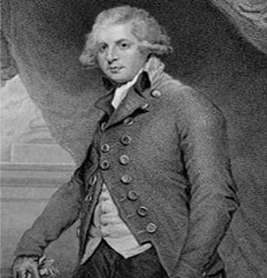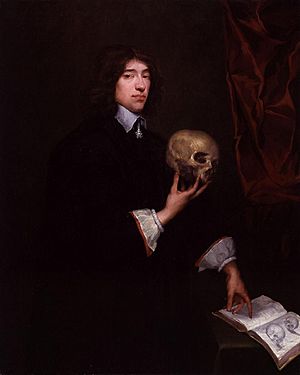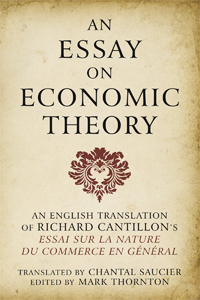Richard Cantillon facts for kids
Quick facts for kids
Richard Cantillon
|
|
|---|---|
 |
|
| Born | 1680s |
| Died | 1734 (aged about 54) London, England, Great Britain
|
| Era | Age of Reason |
| Region | Western philosophy |
| School | Physiocracy |
|
Main interests
|
Political economy |
|
Notable ideas
|
Entrepreneur as risk-bearer, monetary theory, spatial economics, theory of population growth, cause and effect methodology |
|
Influences
|
|
|
Influenced
|
|
| Signature | |
Richard Cantillon (born in the 1680s – died in May 1734) was an important Irish-French thinker. He wrote a famous book called Essai Sur La Nature Du Commerce En Général. This title means Essay on the Nature of Trade in General. Many people, like William Stanley Jevons, called it the "cradle of political economy". This means it was one of the very first complete books about how economies work.
We don't know a lot about Cantillon's life. But we do know he became a very successful banker and merchant. He got rich partly because of his family's connections. He also worked for a powerful person named James Brydges. In the early 1700s, Cantillon made a lot of money from a big financial plan called the Mississippi Company. This plan was started by John Law. Cantillon's success, however, caused problems with people who owed him money. He faced many legal challenges until he died in 1734.
His book, Essai, is the only one of his writings about economics that still exists. He wrote it around 1730. It was shared as handwritten copies for a long time before it was finally published in 1755. The book was very important for early ideas in economics. It influenced the physiocrat and classical schools of thought. But then it was mostly forgotten until it was found again in the late 1800s. Cantillon's experiences as a banker, especially with the speculative bubble of the Mississippi Company, greatly influenced his ideas. He was also inspired by earlier economists like William Petty.
Essai is seen as the first full book on economics. It introduced many new ideas. These include his way of looking at cause and effect in economics. He also had new theories about money and how prices work. He was the first to describe an entrepreneur as someone who takes risks. He also developed ideas about how geography affects markets, which is called spatial economics. Cantillon's Essai had a big impact on early economic thinkers. These included Adam Smith, Anne Turgot, and François Quesnay.
Contents
Richard Cantillon's Life Story
We don't have many details about Richard Cantillon's early life. He was likely born in the 1680s in County Kerry, Ireland. His father, also named Richard Cantillon, owned land in Ballyheigue. Around 1705, Cantillon moved to France and became a French citizen.
By 1711, Cantillon was working for James Brydges. Brydges was a British official who handled money for the army. Cantillon helped manage payments to British prisoners during a war in Spain. He stayed in Spain until 1714, making many important business and political friends. Then he went back to Paris.
Cantillon started working in banking for a cousin. His cousin ran the Paris branch of their family's bank. Two years later, with help from James Brydges, Cantillon bought out his cousin. He became the owner of the bank. Because of his family and Brydges, Cantillon became a very successful banker. He was especially good at moving money between Paris and London.
The Mississippi Company and Its Impact
Around this time, Cantillon got involved with John Law. Law was a British merchant who had a big idea. He believed that if a country printed more money, it would create more jobs and make the economy stronger. In 1716, the French government let Law start a bank called Banque Générale. They also gave him control over developing French lands in North America, which was called the Mississippi Company. Law promised to help the French government pay off its debts.
Law started a financial craze by selling shares in the Mississippi Company. He used his bank's power to print money to help people buy these shares. Richard Cantillon made a huge fortune from this. He bought shares early and sold them when their prices were very high. Even though he thought Law's plan "was unsound and was bound to fail," he still profited.
Cantillon's success caused problems with John Law. Law even threatened to put Cantillon in prison if he didn't leave France. Cantillon famously replied, "I shall not go away; but I will make your system succeed." In 1718, Law, Cantillon, and another rich investor formed a company. They aimed to fund more land deals in North America.
In 1719, Cantillon left Paris for Amsterdam. He came back briefly in early 1720. He arranged for money owed to him in Paris to be paid in London and Amsterdam. When Law's "Mississippi bubble" burst, Cantillon was able to collect on debts that had very high interest rates. Many of his debtors had lost money in the crash. They blamed Cantillon for their losses. He faced many legal challenges from them until he died.
Later Life and Death
On February 16, 1722, Cantillon married Mary Mahony. Her father was a rich merchant and former Irish general. For much of the 1720s, Cantillon and Mary traveled across Europe. They had two children. Their son died young, but their daughter, Henrietta, grew up and married two different noblemen.
Even though he often visited Paris between 1729 and 1733, Cantillon lived mainly in London. In May 1734, his house in London burned down. Most people believe Cantillon died in that fire. The cause of the fire is not clear. Some people think he was murdered. One of his biographers, Antoine Murphy, suggested another idea. He thought Cantillon might have faked his own death to escape his debtors. Murphy believed Cantillon might have gone to Suriname under a different name.
Cantillon's Economic Ideas
Richard Cantillon wrote many papers, but only his book Essai Sur La Nature Du Commerce En Général (or Essai for short) has survived. He wrote it in 1730, and it was published in French in 1755. It was later translated into English in 1932. This book had a huge impact on the early development of economic science.
However, Cantillon's work was mostly ignored during the 1800s. In the late 1800s, William Stanley Jevons "rediscovered" it. Jevons called it the "cradle of political economy." Since then, more people have paid attention to Essai. It is seen as the first complete book on economic theory. Some even call Cantillon the "father of enterprise economics."

One of the biggest influences on Cantillon was the English economist William Petty. Petty wrote a book called Treatise on Taxes in 1662. While Petty laid some groundwork, some experts say his influence might be overstated. Other thinkers who might have influenced Cantillon include John Locke and Isaac Newton. Cantillon's own experience with John Law's financial bubble was also very important. It likely helped him understand how more money in the economy affects prices and production.
How Cantillon Studied Economics
Cantillon's Essai uses a special way of thinking about economics. He focused on understanding cause and effect. This made his work different from earlier thinkers. He often used the word "natural" to show how one economic action leads to another.
Economist Murray Rothbard said Cantillon was one of the first to study economic events using simple models. In these models, he could keep some things fixed to see how others changed. Cantillon often used the idea of ceteris paribus. This Latin phrase means "all other things being equal." It helped him focus on one variable at a time. He also looked at complex economic ideas by starting with simple observations. This is similar to how some modern economists think.
Because he focused on cause and effect, Cantillon took a more neutral approach to economics. He wasn't as interested in whether an economic action was good or bad. Instead, he wanted to explain how things worked. This helped separate economic science from politics and ethics more than before.
Cantillon's Money Theories
Cantillon's ideas about money were different from earlier thinkers. He explained the difference between wealth and money. He said wealth is "nothing but the food, conveniences, and pleasures of life." He believed that the true value of something came from the land and labor used to make it. But he also understood that market prices are set by how much of a good is available (supply) and how much people want it (demand).
He thought that market prices tend to move towards the true value of a good. If the price of something changes, it can affect how much profit businesses make. This might lead them to produce more or less of that good.
In Essai, Cantillon improved on John Locke's idea of the quantity theory of money. This theory says that if there's more money, prices will go up. Cantillon added that inflation happens slowly. He also said that new money affects prices in specific places first. This idea is now called the Cantillon Effect. It means that the first people to get new money benefit the most. They can buy things before prices go up everywhere. Later, when the money spreads, prices rise for everyone else.
Cantillon also thought that how fast money moves (how often it's spent) affects prices. He believed that only real money, like gold or silver, counted as the money supply. But he also said that bank notes (like paper money) could affect prices. This happens by making the real money seem to move faster. He also explained the difference between bank notes that are like receipts for real money and those that are printed without enough real money to back them up. He thought people's trust was key for these extra bank notes to work.
Cantillon also had ideas about international trade. He explained that if a country has a lot of money, its prices will go up. This makes its goods more expensive for other countries to buy. So, it becomes less competitive. He suggested that governments should save money to avoid rising prices and stay competitive. He also believed that a country could keep good trade by making better products.
Cantillon also had an advanced theory about interest rates. He thought that interest comes from borrowers needing money and lenders being afraid of losing it. So, borrowers pay lenders for the risk. Interest is paid from the profits made by using the borrowed money. He believed that interest rates are set by how much money is available to lend and how much people want to borrow. This idea is similar to what David Hume later said.
Other Important Ideas
While Jean-Baptiste Say is often given credit for the term "entrepreneur," it was Cantillon who first used it in Essai. Cantillon divided society into two main groups: those with fixed incomes (like wage-earners) and those with uncertain incomes. He said entrepreneurs are the ones with uncertain incomes. They pay known costs to make products but earn uncertain money because they don't know exactly how much people will want their product. Cantillon didn't fully develop a theory of uncertainty, but he laid the groundwork. He also thought that entrepreneurs help balance the market by guessing what customers want.
Spatial economics looks at how distance and area affect markets. This includes transportation costs and geographical limits. While Johann Heinrich von Thünen is often credited with this field, Cantillon discussed it almost a century earlier. Cantillon explained how transportation costs affect where factories, markets, and cities are located. He believed people try to lower their transportation costs.
He had three main ideas about spatial economics:
- Raw materials of the same quality will cost more near a capital city because of transport costs.
- Transportation costs vary by type (water transport was often cheaper than land).
- Larger goods that are harder to move will always be cheaper closer to where they are made.
For example, Cantillon thought markets were set up to reduce costs for both merchants and villagers. He also believed that where cities were located depended a lot on how wealthy the property owners were. Richer owners could afford to live farther from their property because they could pay for transportation.
Besides his ideas on entrepreneurs and spatial economics, Cantillon also had a theory about population growth. Unlike William Petty, who thought there was always enough land for growth, Cantillon believed that populations only grow as long as there are economic opportunities. He listed three things that affect population size: natural resources, technology, and culture. So, populations only grow as much as these three things allow. Cantillon's population theory was more modern than some later ones. He understood that population growth tends to slow down as a society becomes more developed.
Cantillon's Influence on Others
Even though Essai wasn't published until 1755, it was widely read as a handwritten manuscript. It greatly influenced many early thinkers of the classical school, like Turgot and other physiocrats. Cantillon was a major influence on the physiocrat François Quesnay. Quesnay likely saw Cantillon's work through another nobleman who had a copy of Essai since 1740.
While it's clear that Essai influenced Quesnay, how much is still debated. Some evidence suggests Quesnay didn't fully understand all of Cantillon's ideas. Many of Quesnay's economic beliefs were already in Essai. But Quesnay also disagreed with some of Cantillon's points, like the idea of land scarcity. Still, because of his influence on Quesnay, Henry Higgs called Cantillon the "father of physiocracy." It's also possible that Cantillon influenced Scottish economist James Steuart.
Cantillon is one of the few economists mentioned by Adam Smith. Smith directly used Cantillon's idea about how wages are just enough for people to live on. Many parts of Smith's economic theory might have been directly influenced by Cantillon. However, Adam Smith also developed many ideas far beyond Cantillon's work. Some economic historians believe that Adam Smith didn't add much new from his own ideas. In any case, through his influence on Adam Smith and the physiocrats, Cantillon was likely the most important pre-classical economist for the ideas of the classical school. For example, Cantillon's influence on Jean-Baptiste Say is clear in how Say approached his own book, Treatise on Political Economy.
Images for kids
See also
 In Spanish: Richard Cantillon para niños
In Spanish: Richard Cantillon para niños







